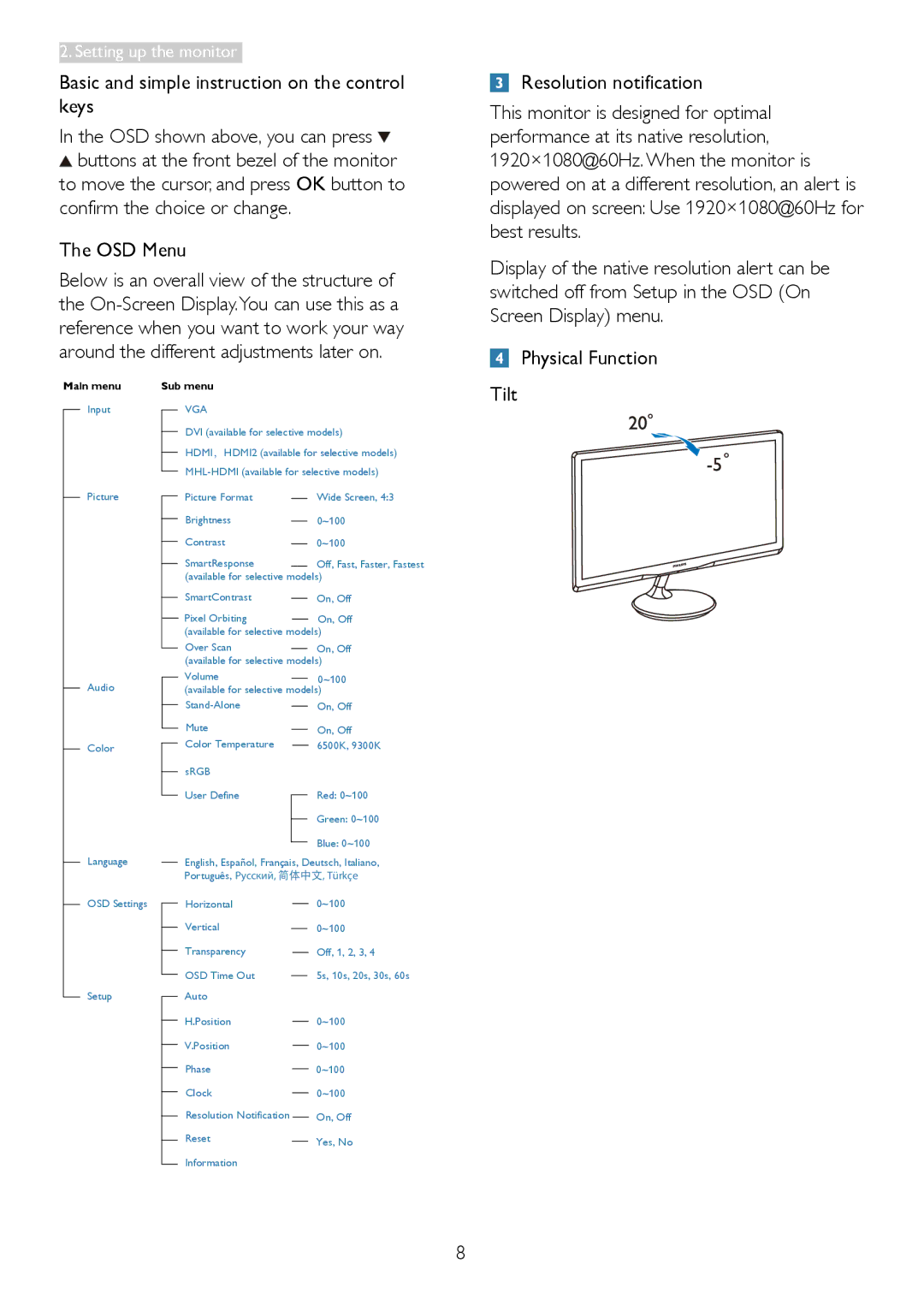
2. Setting up the monitor
Basic and simple instruction on the control keys
In the OSD shown above, you can press ![]()
![]() buttons at the front bezel of the monitor to move the cursor, and press OK button to confirm the choice or change.
buttons at the front bezel of the monitor to move the cursor, and press OK button to confirm the choice or change.
The OSD Menu
Below is an overall view of the structure of the
Main menu | Sub menu |
InputVGA
DVI (available for selective models)
HDMI,HDMI2 (available for selective models)
Resolution notification
This monitor is designed for optimal performance at its native resolution, 1920×1080@60Hz.When the monitor is powered on at a different resolution, an alert is displayed on screen: Use 1920×1080@60Hz for best results.
Display of the native resolution alert can be switched off from Setup in the OSD (On Screen Display) menu.
Physical Function
Tilt
Picture
Audio
Color
Language
OSD Settings
Setup
Picture Format |
|
|
| Wide Screen, 4:3 |
| ||||
Brightness |
| 0~100 | ||
| ||||
Contrast |
| 0~100 | ||
| ||||
SmartResponse |
|
|
| Off, Fast, Faster, Fastest |
(available for selective models) | ||||
SmartContrast |
|
|
| On, Off |
|
|
| ||
Pixel Orbiting |
|
|
| On, Off |
|
|
| ||
(available for selective models) | ||||
Over Scan |
|
|
| On, Off |
|
|
| ||
(available for selective models) | ||||
Volume |
|
| 0~100 | |
|
| |||
(available for selective models) | ||||
|
|
| On, Off | |
|
|
| ||
Mute |
|
|
| On, Off |
|
|
| ||
Color Temperature |
|
|
| 6500K, 9300K |
|
|
| ||
sRGB |
|
|
|
|
User Define |
|
|
| Red: 0~100 |
|
|
|
| Green: 0~100 |
|
|
|
| |
|
|
|
| Blue: 0~100 |
|
|
|
| |
English, Español, Français, Deutsch, Italiano, Português, Русский, 简体中文, Türkçe
Horizontal |
|
|
|
| 0~100 | ||||
|
|
|
| ||||||
Vertical |
|
|
|
|
| 0~100 | |||
|
|
|
|
| |||||
Transparency |
|
|
|
|
| Off, 1, 2, 3, 4 | |||
|
|
|
| ||||||
OSD Time Out |
|
|
|
|
|
|
|
| 5s, 10s, 20s, 30s, 60s |
|
|
|
|
|
|
| |||
Auto |
|
|
|
|
|
| |||
H.Position |
| 0~100 | |||||||
| |||||||||
V.Position |
|
| 0~100 | ||||||
| |||||||||
Phase |
|
|
|
| 0~100 | ||||
|
|
|
| ||||||
Clock |
|
| 0~100 | ||||||
|
| ||||||||
Resolution Notification |
|
|
|
|
| On, Off | |||
|
|
|
|
| |||||
Reset |
|
|
|
|
|
| Yes, No | ||
|
|
|
|
|
| ||||
|
|
|
|
|
|
|
|
| |
Information
8
